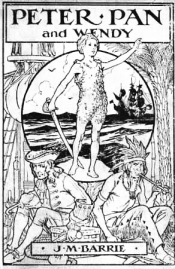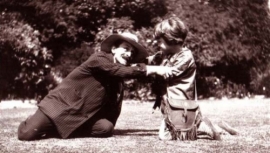When one reads any Peter Pan works by J.M. Barrie, one may note dark undertones for a tale that is depicted as lighthearted and encouraging of the free spirit. Much of Barrie’s own experiences contributed to the work and it is said this is the reason for any of his works’ peculiarities. Barrie was described as childlike, no taller than 5’4” and almost incapable of real adult relationships. This fixation on childhood may be in part due to the loss of his brother David, who died two days shy of his 14th birthday in an ice skating accident. David was his mother’s favorite child (or so we think), and Barrie spent much of his childhood dressing in David’s clothing and trying to console his mother of her loss. Barrie began to fill the shoes of what is known as a “replacement child.” In most cases, a replacement child is a child born after the death of a sibling, however, when David died, expectations for his life and future fell onto Barrie.
One can draw a few parallels between Peter Pan and David, as Peter does not grow up and David is barred from adulthood in his death. Peter & Wendy opens with the famous line, “Every child grows up, except one.” David, who died at 14, is frozen at that age in childhood. He will never be thought of as a grown man or adult, but forever as an individual untouched by the experiences of adulthood. Many people often ask why or how Peter gains the ability to fly, and one may argue that he is in fact a ghost thus having the ability to fly to “other worlds” such as Neverland. Peter Pan also buries young children in Peter Pan in Kensington Gardens and leads the lost souls of children in Peter & Wendy. These roles have very much to do with the dead and perhaps Peter performs these duties because he feels partial to dead children, as he is one.
Peter Pan is a mysterious figure in children’s literature that has intrigued and fascinated people always. We all experience a sense of never wanting to grow up and this has allowed Peter to remain such a prevalent character in literature, movies, and other works. Though his origins are unknown, one thing is certain: Peter and his stories are peculiar. Peter Pan works have a few minor creepy details and this may be attributed to Barrie’s childhood experiences especially given the loss of David and having to replace him in order to console his unstable mother.


I think that your ideas about replacement children are really interesting ones. In terms of David, I see him as the child that needs to be replaced, but also as the romantic child. As you said, he is “frozen at that age in childhood…an individual untouched by the experiences of adulthood.” As we have discussed in class, Barrie was writing during the transition from the Victorian era into the Edwardian. David is the Victorian ideal of the romantic child. He died in his innocent, childlike state and so was therefore able to remain an unscathed child forever. We see this idea throughout children’s literature of the era, such as Ellie in The Water Babies, who is the epitome of the sweet and innocent child. She dies and is immortalized as the perfect child. This same phenomenon occurs with David.
Peter is also a child who was replaced, and for me he is also a kind of romantic child. However, he embodies not the Victorian ideal, but the Edwardian. The Edwardians were much more free-spirited than their Victorian predecessors and we see that in the way in which Peter is immortalized as an eternal child. He does not die, and so remain frozen, as David does, but is instead exiled to a land where he can continue to exist forever as a child in a living state. While our first replacement child, David, is frozen as a perfect, unspoiled child, Peter is allowed to continue on as a rambunctious, carefree kid. In David and Peter, we see the evolving ideal of the romantic child.